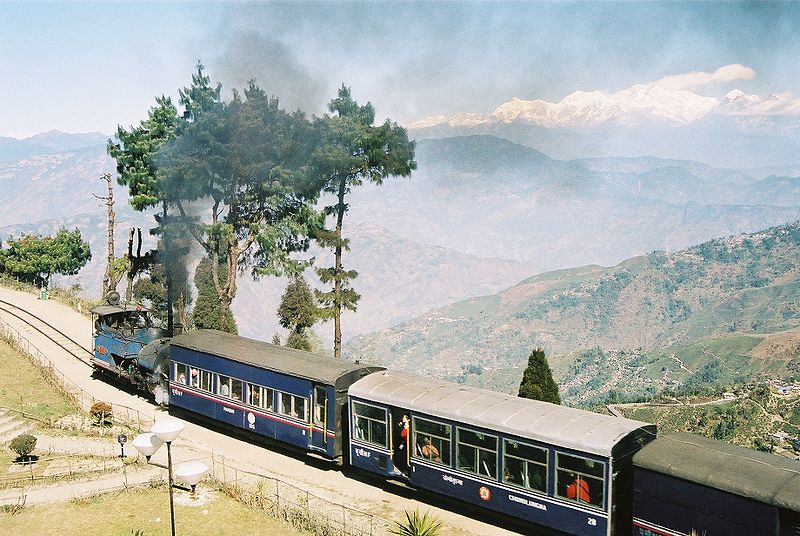If you think a tiny string of painted steel boxes balancing precariously on all of a 2-foot-wide track meandering on the hillside is an unlikely candidate for the UNESCO World Heritage Site status, think again.
It may not be as magnificent as Humayun’s Tomb or Hampi, which also have the same status, but there is something endearing about the grandiloquently named Darjeeling Himalayan Railway (DHR).
It is the second railway system in the world to get Heritage status after the Zimmerin Railway in the gorgeous Austrian Alps. DHR now rubs shoulders with VIP sites around the world such as the Grand Canyon and the Niagara Falls. If you’re still not impressed, you certainly will be when you travel on the quaint train.
But mind you, the journey is not for the hurried and hassled who seek instant gratification. It is for those who believe — as they say in some airline ads — that the journey is the destination. It takes all of 6.5 hours to traverse a distance of about 88 km from New Jalpaiguri to Darjeeling — in fact, you’d probably reach earlier if you walked alongside the track.
But a journey on the DHR offers you a unique glimpse into the rich tapestry of life in Gorkhaland like no other. Therefore, my advice is, take the train — if you have all the time in the world, that is.

Darjeeling HImalayan Railway (Photo by A M Hurrell)
It offers you the Himalaya in rectangular steel frames. Rolling hills, rhododendron slopes, red-tiled cottages, little red riding hoods on bikes flash by frame after frame. As the toy train puffs its wheezing way up through the hillside and right into the heart of the villages and towns that dot the route, it feels as though you’re chugging right through people’s houses, shops and lives.
You could put your hand out of the window and help yourself to a toffee from the jar on shop counters, literally feel the heat of the fires being stoked in the tea stalls, and dodge a ball flying through your window straight off the little boy’s bat. Mercifully, every cottage window that you can reach across and touch is curtained, otherwise the journey could have given you some X-rated entertainment too along the way. After all, Darjeeling is a honeymooner’s paradise.
Between communing with townsfolk, you’ll trundle through stretches of hillsides where prickly bamboo leaves will brush your face if you lean out of the window. Not to mention the tiny bits of charcoal that fly straight out of the boiler room and lodge themselves in your eyes, hair and nose. But you’ll survive all these and more — and the trip is well worth the inconvenience.
Where else can you get such tantalising glimpses of Mt Kangchendzonga with its snowy crown at every turn and bend? And those of you on the wrong side of 40 might recall the haunting melody of Mere sapnon ki rani kab aayegi tu? in Aradhana, the 70s blockbuster.
The real scene-stealer there was neither Rajesh Khanna with his antics on the jeep nor the coy Sharmila Tagore stealing furtive glances at her hero — it was the DHR chugging along the route and playing cupid to the protagonists of the film.
The DHR is a constant wonder on this route — not to the tourists and visitors for whom it is a novelty, but to the residents. They stop everything they’re doing to gape at the train although it chugs along this route at least twice daily.
The strident whistle, the menacing hiss of the engine, the jet-black plume of carbon smoke it spews and the horrendous traffic snarls it creates in the narrow hill roads would have driven anyone but the hardiest city dweller nuts, but not our folk from Gorkhaland.
They look on indulgently; it is their pride and their passport to prosperity. It brings precious cargo — in the form of 5,000 tourists a day in peak season — tourists who will spend precious dollars and more frequently, less precious rupees and rupiahs. But spend they will — and in anticipation, the hillsides have sprouted cottages and ugly multi-storeyed hotels, lodges, guest houses and tourist homes.

Toy Train, Darjeeling (Photo by Aranya)
The track and the road travel alongside all the way from Siliguri to Darjeeling, much like two mismatched snakes in courtship. At times they appear to be feuding when the rail track moves away from the road to play hide and seek for a while before it emerges rather coy and choose to travel to Darjeeling.
But there was a time when the DHR was considered fast — by the sahibs and memsahibs who had to trudge up the hill on their ponies. Mountain terrain is harsh and unyielding, and every foot quarried from its side and tamed into something resembling a road is a triumph of human ingenuity and sheer bloodymindedness. The Brits had these qualities in ample measure, and with the aid of a labour force commandeered from among the Nepalese and the Lepcha, drove a stairway through the heart of the mountains in the mid-19th century. First, they built the precipitous Military Road down Punkhabari way, and then found it was so steep that no cart could go uphill.
So the gentler, and longer, Cart Road was built connecting Siliguri with Darjeeling, which to this day remains the preferred approach to Darjeeling. Then, in 1879, Franklin Prestage of The Eastern Bengal Railway Company had a dream — of building a tramway line from Siliguri to Darjeeling, the queen of the Himalayan hill stations. In those days, Darjeeling could be accessed only on ponies through a hill cart track.
There was as yet no mountain railway anywhere in the country and Prestage was no engineer. Yet, he believed he could build a tramway track along the hill track alignment. It was to be a unique track — just 2 ft wide. He managed to convince his bosses about the feasibility of the project. Construction began on the 51-mile line (as it was then referred to) in the same year. At the 14th mile, Prestage got stuck. The gradient was too steep.
A crestfallen Prestage had almost given up, conceding defeat. It was then that, train lore has it, his wife came up with a suggestion — why not go backwards, if you can’t go forward? Thus was born the most innovative railway system in the world: the Darjeeling Himalayan Railway. The line reverses every time it is unable to move forward because of the gradient — in the shape of ‘Z’, to make the climb at a slightly different point. At times it loops around those impossibly steep gradients, like a spiral, crossing itself at a slightly higher altitude. It maintains a constant incline of 1:20, that is, for every 20 ft travelled, the train gains one foot of elevation.
At Ghoom, the highest railway station in the world to be reached by a steam engine, the DHR reaches 7,407 ft. Prestage completed the construction of the DHR in two years. It has been running continuously since. For decades, it has ferried tea in wooden chests from the verdant slopes of Margaret’s Hope, Makaibari, Happy Valley and a score of other tea gardens to the shores from where they were shipped to Harrods of London and Saks of Manhattan, New York.
In fact, it would be no exaggeration to say that DHR put Darjeeling on the world tea map long before it put it on the world heritage sites map. Most inimitably, however, ever since the Siliguri-Kurseong-Darjeeling line was flagged open in 1880-81, steam, and steam alone, has been the motive force powering the train over the mountains. (There was, in fact, a mercifully brief flirtation with diesel somewhere along the way, but we’ll not talk about that.) While locomotion has changed beyond recognition over most of the world, the Darjeeling Himalayan Railway continues to be a delightful 19th century relic, proudly unfurling its banner of steam across the face of the mountains.
About Darjeeling Himalayan Railway
The history of the DHR is an unalloyed delight for train spotters of all shapes and sizes. Franklin Prestage of The Eastern Bengal Railway Company first approached the government with the plan of building a tramway connecting Siliguri with Darjeeling. Following the report of a committee chaired by Ashley Eden, then lieutenant-governor of Bengal, the firm of Gillander, Arbuthnot & Co began work in 1879. There are two distinct schools of thought about the engineering feats of the firm that built the railway.

Darjeeling Toy Train (Photo by Supernova explosion)
Most believe that the railway was an engineering marvel, and cite the ways in which the problem of steep gradients was tackled. Instead of building tunnels, which was time-consuming and expensive, loops and reverses (also known as zig-zags or switchbacks) were constructed, first between Sukna and Gayabari and later elsewhere.
However, there are some who believe that the most difficult part of the engineering had already been completed by those who had laid the roadworks about half a century ago. According to LSS O’Malley, whose extraordinary work on Darjeeling in the Bengal District Gazetteers Series in 1907 still remains the last word on the subject: “The line was open for traffic as far as Kurseong in 1880, and in 1881 it was carried as far as Darjeeling, the steam tramway being then dignified with the name of a railway.”
Elsewhere, he asserts that it was an exaggeration to call the railways a “wonderful piece of engineering work” as the road on which it was constructed was already made, and no serious tunnelling was involved. Be that as it may, by the first decade of the 20th century, the DHR was carrying 1,74,000 passengers and 47,000 tons of goods annually, and extensions to the line were taking place, up to Kishanganj in 1914, and Gielkhola in 1915. The loop at Batasia was built in 1919.
There were occasional calamities, such as earthquakes in 1897 and 1934, and a cyclone in 1899. The railway tided over these crises and played a vital role during the Second World War, transporting men and munitions to various military camps near Ghoom and Darjeeling. After Independence, DHR was absorbed in the Indian Railway, and became a part of the Northeast Frontier Railway zone in 1958.



